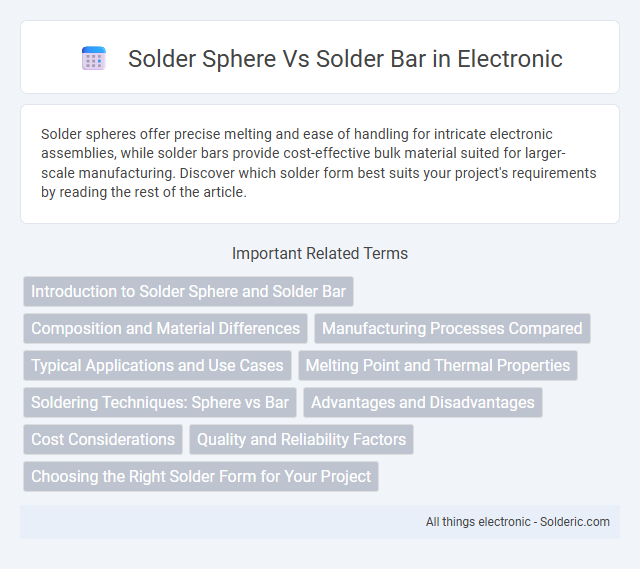Solder spheres offer precise melting and ease of handling for intricate electronic assemblies, while solder bars provide cost-effective bulk material suited for larger-scale manufacturing. Discover which solder form best suits your project's requirements by reading the rest of the article.
Comparison Table
| Feature | Solder Sphere | Solder Bar |
|---|---|---|
| Form | Pre-formed spherical balls | Solid metal bars |
| Usage | Surface mount technology (SMT), ball grid arrays (BGA) | Wave soldering, manual soldering, reflow soldering (after processing) |
| Melting Characteristics | Uniform melting, precise control in reflow | Requires melting before application |
| Handling | Easy placement with pick-and-place machines | Needs to be cut or melted down for use |
| Application Precision | High precision for advanced electronics | Less precise, suited for bulk soldering |
| Common Alloys | Sn63Pb37, SAC305, Lead-free variants | SnPb, SnCu, Lead-free alloys |
| Cost Efficiency | Higher cost due to precision and form | Lower cost, bulk availability |
| Storage | Requires moisture and contamination control | Less sensitive to storage conditions |
Introduction to Solder Sphere and Solder Bar
Solder spheres are small, pre-formed balls of solder alloy typically used in surface mount technology for precise application during electronic component assembly. Solder bars, on the other hand, are larger, solid pieces of solder alloy primarily utilized in wave soldering and bulk soldering processes for circuit boards. Your choice between solder spheres and solder bars depends on the specific manufacturing technique and the precision required for the assembly.
Composition and Material Differences
Solder spheres are typically composed of uniform, pre-alloyed materials like tin-lead, SAC (tin-silver-copper), or lead-free formulations, offering precise control over alloy composition and melting characteristics. Solder bars, on the other hand, are bulk forms often made from similar alloys but require melting and mixing before application, which can result in varying composition consistency. Your choice between solder sphere and solder bar depends on the need for consistent material properties and application methods in electronics manufacturing.
Manufacturing Processes Compared
Solder spheres are produced through controlled atomization or drop-solidification processes, ensuring uniform size and precise composition ideal for fine-pitch electronic assemblies. Solder bars, formed by casting and rolling, offer bulk material for various soldering applications but require melting and reshaping before precise use. Your choice depends on the specific manufacturing needs, with spheres providing consistency for surface-mount technology and bars favored for manual or wave soldering.
Typical Applications and Use Cases
Solder spheres are predominantly used in microelectronics for ball grid array (BGA) packaging, flip-chip technology, and surface-mount device assembly due to their precise, uniform size enabling reliable connections on small, intricate components. Solder bars are commonly employed in wave soldering, solder pot dipping, and manual soldering processes for larger joints and mass production, offering ease of handling and controlled melting in high-volume manufacturing. The choice between solder spheres and bars depends on factors such as component density, assembly complexity, and production scale in electronics manufacturing.
Melting Point and Thermal Properties
Solder spheres typically have a more uniform melting point due to their consistent alloy composition and controlled size, which ensures precise thermal performance during soldering processes. Solder bars, being bulkier and less uniform, may exhibit variations in melting behavior and slower heat transfer rates, impacting thermal efficiency. The high thermal conductivity of solder spheres enables rapid heat conduction and better temperature control, whereas solder bars require longer heating times to reach the optimal melting point.
Soldering Techniques: Sphere vs Bar
Solder spheres offer precise control over solder volume and placement, making them ideal for advanced soldering techniques like ball grid array (BGA) reflow and fine-pitch components. In contrast, solder bars require melting and manual application, which suits traditional soldering methods and larger surface areas but may lack uniformity and precision. The choice between solder spheres and bars directly impacts solder joint quality, thermal management, and assembly efficiency in electronics manufacturing.
Advantages and Disadvantages
Solder spheres offer precise control in small-scale applications, enabling uniform melting and enhanced joint quality, but they can be costlier and require specialized handling compared to solder bars. Solder bars provide bulk material ideal for large-scale soldering tasks, offering cost efficiency and easier storage, yet they may result in uneven melting and less accuracy in fine-pitch electronic assemblies. Choosing between solder spheres and bars depends on the balance between precision needs, production volume, and budget constraints.
Cost Considerations
Solder spheres generally incur higher costs than solder bars due to their precision manufacturing and uniform size, which enhance reliability in electronic assembly processes. Solder bars offer a cost-effective option by providing bulk material suited for high-volume soldering needs, reducing per-unit expenses. Choosing between solder spheres and solder bars depends on balancing upfront material costs against assembly quality and production efficiency.
Quality and Reliability Factors
Solder spheres offer superior quality with uniform shape and size, ensuring consistent melting and wetting properties critical for reliable electronic connections. Solder bars, while more cost-effective, may have variations in alloy composition, impacting solder joint integrity and increasing the risk of defects. Enhanced quality control in solder spheres translates to higher reliability in advanced electronics, minimizing failures caused by uneven solder flow or void formation.
Choosing the Right Solder Form for Your Project
Selecting the appropriate solder form hinges on project requirements such as precision and application method. Solder spheres offer controlled, consistent volume ideal for delicate, automated processes like microelectronics assembly, while solder bars provide bulk material suited for large-scale, manual soldering tasks. Understanding factors like melting point, alloy composition, and workspace ergonomics ensures optimal joint quality and efficiency.
solder sphere vs solder bar Infographic

 solderic.com
solderic.com